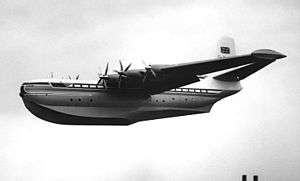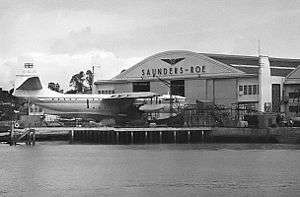Saunders-Roe Princess
| SR.45 Princess | |
|---|---|
 | |
| Saunders-Roe Princess G-ALUN displaying at the Farnborough SBAC Show in September 1953 | |
| Role | Flying boat airliner |
| Manufacturer | Saunders-Roe |
| First flight | 22 August 1952 |
| Number built | 3 (1 flew, others cocooned) |
|
| |
The Saunders-Roe SR.45 Princess was a British flying boat aircraft built by Saunders-Roe, based in Cowes on the Isle of Wight. The Princess was the largest all-metal flying boat ever constructed.[1]
The project was cancelled after having produced three examples, only one of which flew. By the mid-1950s, large, commercial flying boats were being overshadowed by land-based jet aircraft. Factors such as runway and airport improvements added to the viability of land-based aircraft, which did not have the weight and drag of the boat hulls on seaplanes nor the issues with seawater corrosion.
The project was delayed by difficulties with the Bristol Proteus engines.[2]
G-ALUN made 47 test flights between 1952 and 1954, including two appearances at the Farnborough SBAC Show.[3] This work was carried out under a development contract for the Ministry of Supply, the intention being that this would lead to a contract for the aircraft from the flag carrier BOAC. Although the initial contract was successful, BOAC decided instead to develop land-based routes using the jet-powered dH Comet.
The three airframes were stored against possible purchase but when an offer was made it was found that corrosion had set in; as a result they were scrapped.
Design and development
Origins
In 1945, Saunders-Roe was asked by the British Ministry of Supply to bid for a long range civil flying boat for British Overseas Airways Corporation (BOAC), who planned to use them on transatlantic passenger services. Saunders-Roe's bid was successful, and it received an order for three aircraft in May 1946.[4]
The Princess was powered by ten Bristol Proteus turboprop engines, powering six propellers. The four inner propellers were double, contra-rotating propellers driven by a twin version of the Proteus, the Bristol Coupled Proteus; each engine drove one of the propellers. The two outer propellers were single and powered by single engines. The rounded, bulbous, "double-bubble" pressurized fuselage contained two passenger decks, with room for 105 passengers in great comfort.
The ailerons and rudder were split into multiple sections such that if a part of the servo-powered control system failed the faulty section could be "trailed" so that it did not act against the working sections. The planing bottom of the hull had only a slight step in the keel to minimize drag in the air.[5]
Flight testing

In 1951 BOAC reevaluated its needs, and determined it had no need for the Princess. It was announced that construction of the three aircraft would continue as transport aircraft for the RAF.[6] However, in March 1952, it was announced that while the first prototype would be completed, the second and third would be suspended to await more powerful engines.[4]
The prototype, G-ALUN, first flew on 22 August 1952 piloted by Geoffrey Tyson. The planned 2-3 hour flight was curtailed because of false readings on airscrew bearing temperature. Three more flights followed in that week. It appeared at Farnborough in 1953.[7] G-ALUN was the only model to fly, making 46 test flights in total for about 100 hours flying time. It appeared at the Farnborough Airshow in 1953.[8]
Princess Air Transport Co Ltd was formed with the object of studying the factors affecting the operation of the Princess flying boats and to tender for their operation should the opportunity have arisen. The company's directors were M D N Wyatt (chairman), Sir Archibald Hope, Geoffrey Tyson, P D Irons and Capt H W C Alger (general manager). 75% of the share capital were held by Saunders-Roe Ltd and the balance by Airwork Ltd.
Termination of production
Two other Princesses (G-ALUO and G-ALUP) were built, but they never flew. Aquila Airways offered £1 million each for the Princesses in 1954, but this offer was rejected.[9][10] The three aircraft were cocooned, one at Cowes and two at Calshot Spit, with the hope that work would be restarted when a buyer was found.[11] Several offers were made to buy the aircraft, including two which involved re-engining them with Rolls-Royce Tynes,[12] while Saro proposed in 1957 to convert them to landplane troop carriers/freighters.[13] In 1964, they were purchased by Eoin Mekie on behalf of Aero Spacelines, who planned to use them as heavy-duty freight aircraft for transporting Saturn V rocket components for NASA. When the cocooning was removed, it was found that they were badly corroded (the contract for maintenance and inspection of the stored aircraft had been allowed to lapse, which resulted in the airframes deteriorating rapidly), and all three Princesses were broken up by 1967.[14][15]
They were the last fixed-wing commercial aircraft produced by Saunders-Roe. The company built one more fixed-wing design, the Saunders-Roe SR.53 mixed-power (rocket and turbojet) fighter design; aside from that, the company concentrated on helicopters and hovercraft after this point.
While the prototype aircraft had advanced (but conventional) hydraulic controls, S-R intended production aircraft to use an analogue system based around electrical servos with hydraulic final control actuators. Such a system was built and ground-tested, but the Princess project was cancelled before any aircraft was fitted with the system.
Nuclear power
In 1958 information on the Princess was passed to the United States Navy who were looking at the possibility of converting the three stored aircraft to use nuclear power,[16][17] with a team from Saro visiting the US to discuss selling the Princesses. However, the plans came to nothing.[12]
A Pregnant Princess
In the wake of the success of his Pregnant Guppy, constructor Jack Conroy discussed his concepts for other outsize transports with Air Progress in their publication, World's Greatest Aircraft (Petersen Publications, 1973).
The creation of an outsize transport from the Princess was feasible, in that it shares a sectional 'double-bubble' fuselage construction similar to that of the Boeing Model 377 Stratocruiser, on which the Guppies were based. The reason for considering this was the desire of NASA to have the first stage of the Saturn V rocket transported by air if possible to Cape Canaveral, and a water landing would be advantageous for proximity landing at sea, or on nearby lakes in Florida.
Ultimately, this plan was deemed impractical, though the Guppies continued to function throughout the Apollo program as efficient air transport of hardware used in these missions.
Conroy quipped that the British were "offended when we named our aircraft 'The Pregnant Guppy'. Man, can you imagine what they would have said if we produced 'The Pregnant Princess' !" [18]
Specifications
Data from Saunders and Saro Aircraft since 1917[19] British Flying Boats[20] and Flight 1952
General characteristics
- Crew: 2 pilots, 2 flight engineers, radio operator and navigator
- Capacity: 105 passengers in tourist and first class cabins / 137,000 lb (62,142.2 kg) disposable load
- Length: 148 ft (45 m)
- Wingspan: 219 ft 6 in (66.90 m) with wingtip floats retracted. 209 ft 6 in (63.86 m) floats extended.
- Height: 55 ft 9 in (16.99 m)
- Wing area: 5,019 sq ft (466.3 m2)
- Airfoil: "Saro-modified Goldstein section" to "modified N.A.C.A. 4415 Series" at tip[21]
- Empty weight: 190,000 lb (86,183 kg)
- Gross weight: 330,000 lb (149,685 kg)
- Max takeoff weight: 345,025 lb (156,501 kg)
- Fuel capacity: 14,000 imp gal (63,645.3 l; 16,813.3 US gal) in four integral inner wing tanks.
- Powerplant: 4 × Bristol Coupled-Proteus 610 Coupled turboprop engines (each composed of two Proteus), 2,500 hp (1,900 kW) each + 820 lbf (3.65 kN) residual thrust at 10,000 rpm at sea level.
- Maximum continuous power: 2,050 hp (1,529 kW) + 700 lbf (3.11 kN) residual thrust at 9,500 rpm at sea level.[22]
- Powerplant: 2 × Bristol Proteus 600 Turboprop engines, 2,500 hp (1,900 kW) each + 820 lbf (3.65 kN) residual thrust at 10,000 rpm.
- Maximum continuous power: 2,050 hp (1,529 kW) + 700 lbf (3.11 kN) residual thrust at 9,500 rpm at sea level.[22]
- Propellers: 4-bladed de Havilland constant speed, quick-feathering Duralumin propellers.[23], 16 ft 6 in (5.03 m) diameter
Performance
- Maximum speed: 380 mph; 611 km/h (330 kn) at 37,000 ft (11,000 m)
- Cruise speed: 360 mph (313 kn; 579 km/h) at 32,500 ft (9,900 m)
- Stall speed: 113 mph; 181 km/h (98 kn) flaps and floats down
- Range: 5,720 mi (4,971 nmi; 9,205 km)
- Endurance: 15 hours
- Service ceiling: 39,000 ft (11,887 m) absolute
- Rate of climb: 1,900 ft/min (9.7 m/s) at 184 mph (296 km/h; 160 kn) at sea level
See also
- Related development
- Aircraft of comparable role, configuration and era
- Related lists
Notes
- ↑ http://www.bbc.co.uk/news/uk-england-hampshire-19279791
- ↑ Wealthy, p. 155.
- ↑ Wealthy, p. 154.
- 1 2 Bridgman 1953, p. 88.
- ↑ Flight 1952, p. 412.
- ↑ "COVER ART"FLIGHT, 16 November 1951
- ↑ Flight 1952, p. 422.
- ↑ Hull 2002, p. ?.
- ↑ "Saunders-Roe S.R.4S Princess." Flight, 3 September 1954, p. 338.
- ↑ London 2003, p. 246.
- ↑ London 1988, pp. 229–230.
- 1 2 London 1988, pp. 230–231.
- ↑ London 1988, pp. 312–313.
- ↑ London 1988, p. 234
- ↑ London 2003, p. 250.
- ↑ "U.S. Given Data On Flying-Boats - Use Of Nuclear Power". The Times, Monday 3 February 1958, Issue 54065. p. 5, column A.
- ↑ Wealthy, p. 187.
- ↑ Air Progress, World's Greatest Aircraft, Chapter: 'The Guppies', concluding paragraph.
- ↑ London, Peter (1988). Saunders and Saro Aircraft since 1917. London: Conway Maritime Press Ltd,. pp. 210–235. ISBN 0 85177 814 3.
- ↑ London 2003, p. 282.
- ↑ Flight 26 September 1952, p. 413.
- 1 2 Saunders-Roe Report FT/15/0/24 Part 1. MAEE Felixstowe. January 1955.
- ↑ Flight 1950, p. 345
References
- Bridgman, Leonard. Jane's All The World's Aircraft 1952-53. London: Jane's, 1953.
- "Concerning flying boats". Flight, 6 July 1951. pp. 10–11.
- "Flying ship on the stocks" Flight, 16 March 1950, pp. 344–345.
- Hull, Norman. Flying Boats of the Solent: A Portrait of a Golden Age of Air Travel. Silver Link Publishing Ltd., 2002. ISBN 1-85794-161-6.
- London, Peter. British Flying Boats. Stroud, UK: Sutton Publishing, 2003. ISBN 0-7509-2695-3.
- London, Peter. Saunders and Saro Aircraft since 1917. London, UK: Conway Maritime Press Ltd, 1988. ISBN 0-8517-7814-3.
- "The Princess: Design Details of the Great Saunders-Roe Flying boat." Flight, 26 September 1952, pp. 411–422.
- "Ten Turboprops Power Giant Flying Boat." Popular Science, August 1949.
- "A winged ship takes form." Flight, 7 December 1951, p. 724.
- "SR/45", Flight LIII (2038), 15 January 1948: 63–68
- Wealthy, Bob (29 January 2009). "Saunders Roe and the Princess Flying Boat" (PDF). Solent Aeromarine Enterprises.
External links
| Wikimedia Commons has media related to Saunders-Roe Princess. |
- Sea Wings Gallery of Images
- Video on Youtube
- "Britain's Biggest Flying Boat," Popular Mechanics, September 1948
| ||||||||||||||||||||||